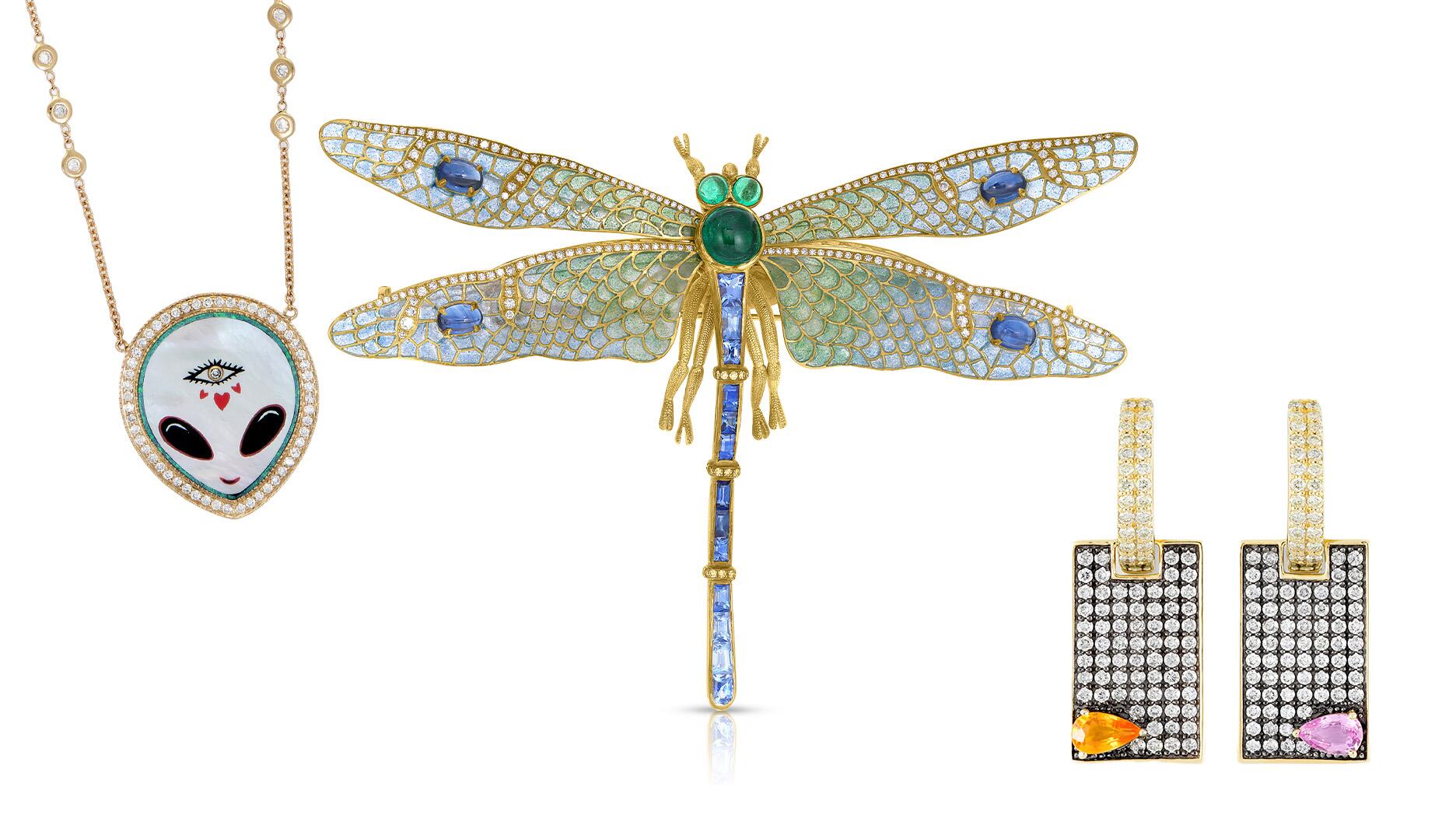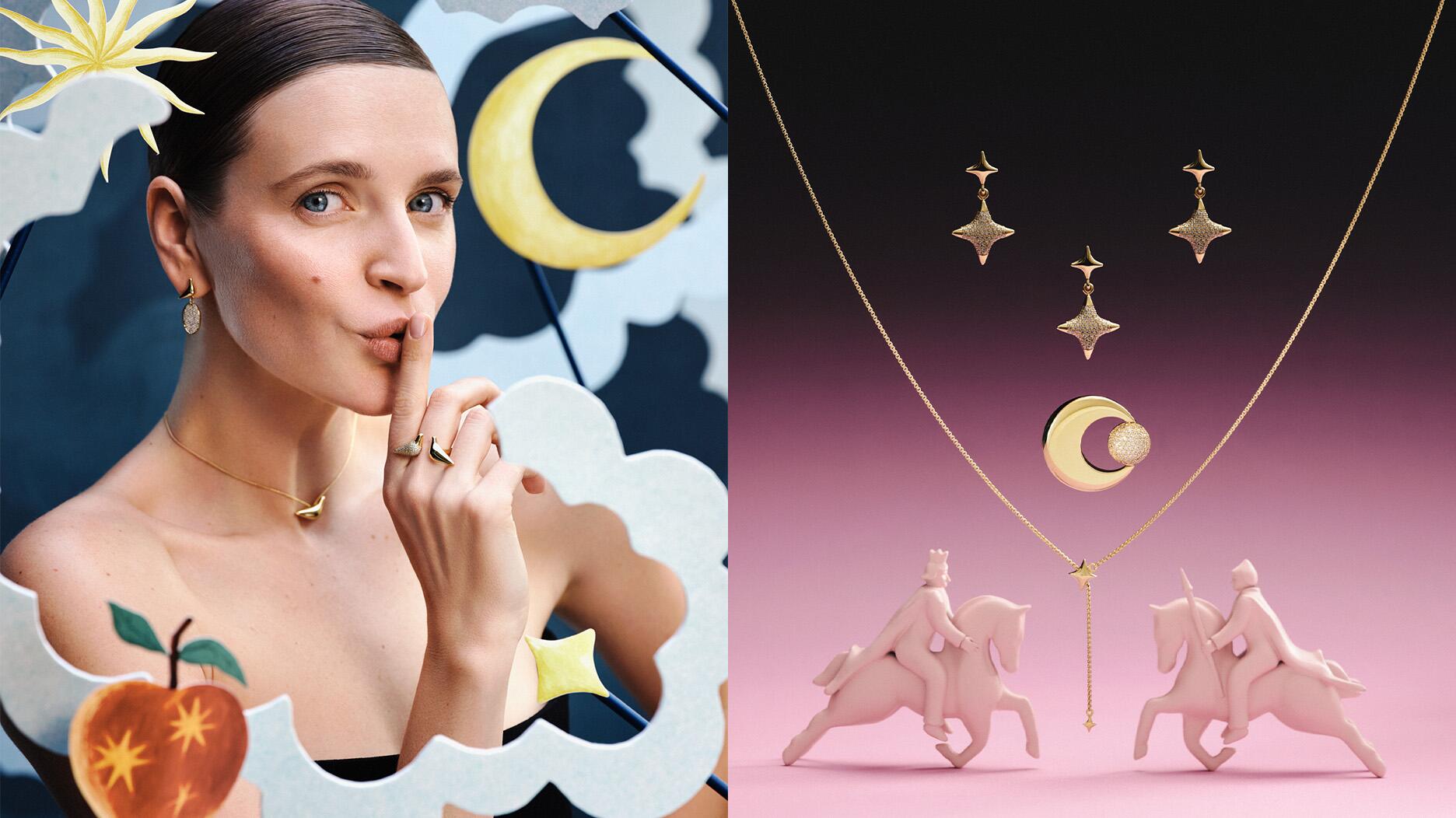Set in a Tiffany & Co. necklace, it sold for $4.2 million, the highest price and price per carat paid for a Paraíba tourmaline at auction.
The State of Jewelry Design: Instagram & the Battle Over IP
Social media sharing has made it easier than ever for copycats to target independent fine jewelry brands. Here’s how designers are fighting back.

“Every single type of company is copying our design,” Kalan says, “including people making jewelry with crystals, semi-precious stones, diamonds, brass, anything. There are also companies who are taking our images from our website and Instagram and using them on their websites and social media to sell the copies. It’s never-ending.”
Perhaps the most troubling, and confusing, part of the equation is that the Fireworks collection is protected under U.S. copyright.
So how does protected work become subjected to so much infringement? The answer is one that is of great concern to today’s abundant crop of independent designers and small business operators.
Copies in the Digital Age
Knockoffs aren’t a new issue for creatives, but the visibility of designs and their replicas is heightened in the digital era.
Brands have more control over and more ways of communicating their image to consumers than ever before through social media, but the exposure they rely on to propel their careers also gives copycats unprecedented access to new pieces.
This double-edged sword cuts for every designer working today; most consider social platforms somewhat of a necessary evil in this regard.
“You have to show what’s new to keep your customers interested and keep them coming back, but at the same time the people who are copying will see it,” Kalan says. “There’s a positive and negative with social media. You can’t help it. That’s the way it is. With social media our brand got bigger and stronger and better and recognized all over the world. At the same time, people who are going to copy are having an easier time.”
Even when designers try to control the timing of product releases on social media, they’re not the only ones sharing.
When Zwart launched Azlee about four years ago, she hadn’t had a chance to even consider what protections her brand might need before she began seeing replicas of her designs. To date, her first collection is still her most copied.
Like Kalan, Zwart has seen copies of her pieces rendered in various materials and at different price points, but the most difficult pill to swallow has been infringement from her fine jewelry contemporaries.
“If someone’s knocking you off in a different metal, it’s hurtful but it doesn’t feel as much of a problem. It’s a totally different price point,” she explains. “But when a (fine jewelry) brand knocks you off and they’re working with similar stores that carry your work I think it definitely impacts business. I always think about the buyers, because it’s really hard for them to pick apart who did what first, along with consumers, especially when it’s someone who is functioning in your realm and is a comparable brand.”
Kalan agrees.
“The worst thing for me is when other designers take your ideas and just manipulate them a teeny- tiny bit and call it their own. I expect it from the companies in China or India whose business is just to copy and sell copies but I really don’t expect it from other fine jewelry designers, yet it’s been happening a lot.”
“I’ve had so many individuals reach out to inquire about a ring and then go have it made somewhere else. With clothing or handbags consumers don’t have the same access to the supply chain as they do with jewelry.” — Baylee Zwart
Aside from the friction of copying among competitors, larger forces like retail chains and department stores can pose a Goliath-esque threat to small, independent companies.
One fashion, accessory and jewelry chain with hundreds of stores nationwide, which has long been a target of copying allegations from various independent designers, has proven to be the giant that Brooklyn, New York-based Wwake must battle.
Designer Wing Yau says that of all the copying she has experienced, the retailer in question (which she declined to name on record), “has the most egregious copies, similar to our designs in scale, style and stone usage,” but these costume versions sell for a small fraction of what her precious metal originals do.
“The scale is exactly the same but the materials have zero integrity,” Yau elaborates. “It’s really interesting because (the store) offers our exact design for less: a lesser price and lesser quality and in a category that is not long-lasting. It’s jewelry that you throw away once you tarnish it or bend it.”
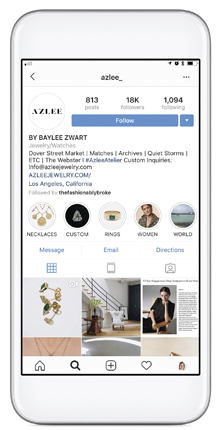
Earlier this year, another big chain found itself at the center of controversy.
Nordstrom began selling a line of costume jewelry—the result of a collaboration between home décor and costume jewelry company Lulu DK and We Wore What blogger Danielle Bernstein—that contained several pieces that were similar to a gaggle of independent designers like Bondeye Jewelry, Foundrae, Marlo Laz and Retrouvai.
Consumers quickly noted the disconcerting design overlap and Instagram fashion watchdog Diet Prada shared the story with its 600,000+ followers. The social outrage, which resulted in mainstream media coverage due to Bernstein’s status as one of the world’s most successful bloggers, had its intended effect—Nordstrom pulled the offending styles.
Pinterest is another social media arena that presents specific challenges.
As Azlee has increased its focus on the custom bridal aspect of the brand, Zwart has learned that copying in the bridal arena happens with relative impunity.
“People make an engagement ring mood board on Pinterest and then find a local jeweler to execute one of the designs. I’ve had so many individuals reach out to inquire about a ring and then go have it made somewhere else. With clothing or handbags consumers don’t have the same access to the supply chain as they do with jewelry. People don’t even think twice about it, to bring a photo to a jeweler and have something copied, and the jeweler doesn’t think twice about it either. It’s totally lost on the consumer that that might be a breach of design ethics.”
What Designers Can Do
The U.S. Constitution provides the foundation for laws that protect designers’ work.
Article 1, Section 8, Clause 8, commonly referred to as the intellectual property clause, charges Congress with the responsibility to “promote the progress of science and useful arts, by securing for limited times to authors and inventors the exclusive right to their respective writings and discoveries.”
“It’s from that provision that we get all the laws in the U.S. about intellectual property,” says Jewelers Vigilance Committee Senior Counsel Sara Yood. “Intellectual property law is a way to protect the output of your brain.”
There are three primary aspects of intellectual property: copyrights, trademarks and patents.
“Basically, the simple way to describe a copyright is it protects the expression of an idea, not the idea itself,” says Mary Kate Brennan, an intellectual property attorney with Epstein Drangel LLP.
Trademarks, meanwhile, protect brand names and logos, while patents are used to allow inventors to protect their inventions for a limited time, though they must be disclosed to the public to promote science.
According to Yood, copyright law is the most applicable when it comes to ensuring a jewelry design does not get replicated.
“The easiest and most logical way for jewelry designers to protect their work is using copyright,” she says. “You actually obtain copyright simply by ‘fixing it in a tangible medium’—that’s the technical language—but really that just means drawing, taking a photo or creating a mold of something. As long as you’re fixing the idea in something tangible, you now have copyright rights on that. It’s automatic; you don’t need the government to tell you that you have it.”
Yood recommends, however, obtaining official copyright registration from the U.S. Copyright Office as “a legal formality, (to) create a public record of the basic facts of when you created it.”
For a $35 fee, officials will decide whether a work (or group of works, such as a collection) rises to the level of originality and therefore will be granted registration.
This is where copyright law becomes murky.
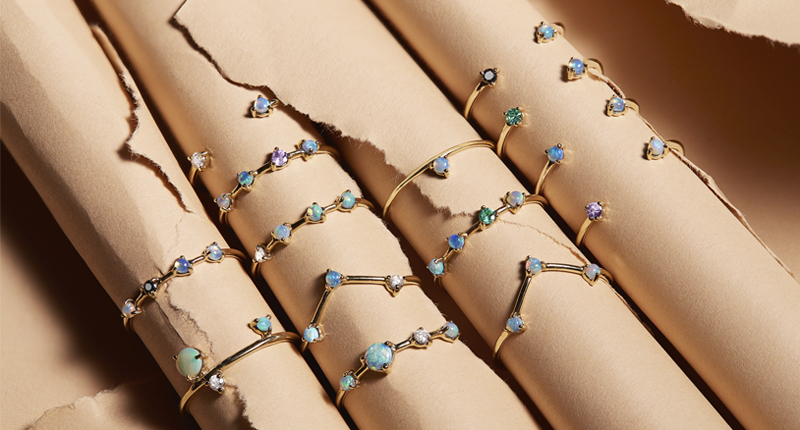
Certain universal principles apply to copyright registration. A plain gold band, for example, can’t be afforded copyright protection because it’s been made before and can’t be attributed to one designer. The utilitarian aspects of jewelry, like a clasp, also are not eligible.
Beyond that, the process by which registration is granted is largely subjective, dependent on the case being made for registration and the opinion of the official reviewing it.
“You have no idea which examiner is going to review your work,” Brennan says. “I don’t want to say it’s luck, but it depends who you get in the copyright office, whether or not they’re going to accept that your creation rises to the level of originality where it receives copyright protection or not. You can dance around with what the technical definition is but, at the end of the day, it’s someone making a judgment while looking at an object.”
Brennan still recommends applying for copyright registration (collections can be submitted in their entirety in the “multiple works” category) because it allows for claims of copyright infringement to be litigated in court, if it is granted.
The nature of Wwake’s work, which is unique to the market for its diminutive scale, ethereality and distinctly handmade feel, has made it difficult for her to obtain registration.
“Even though my sense of proportion and the orientation of my stone setting is very specific to the way I work, those aren’t things that are easy to put on paper in the copyright office so it’s tricky to have them grant a copyright for the type of work that we do,” Yau says. “That’s something I’m really up against with my actual style.”
Even when brands are able to obtain copyright protection, the cost of actual litigation deters many designers from taking perceived copiers to court.
Kalan, whose Fireworks collection is copyrighted, says: “Sending lawyers after these people and taking them to court is going to be very costly. In a way, it’s like focusing our energies into negativity, instead of thinking of what else we could do to move forward.
“I guess that’s what we’re doing—trying to not think about it. We’re not Chanel, we’re not David Yurman, where we can afford a big team of lawyers.”
“It’s a business decision,” says Brennan. “How much money do you have, and how much do you want to spend?”
The Democratic Route
When a copyrighted design is knocked off (keeping in mind that a design is technically copyrighted as soon as it is fixed in a “tangible medium”), Yood advises that designers’ first line of defense should be to obtain copyright registration if they haven’t already and send a cease-and-desist letter through their attorney to the offending party, a practice that is quick and easy to do for an intellectual property lawyer and shouldn’t be costly.
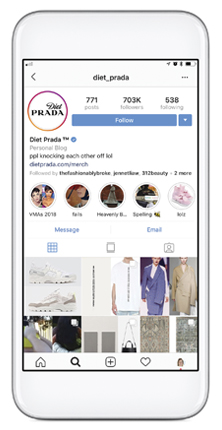
But if a designer doesn’t have a registered copyright, there are ways to take matters into her or his own hands.
“If you do not have a registered copyright and you can’t get one it will absolutely be more difficult to get (copiers) to stop,” Yood says. “I think this is where people tend to go the Diet Prada route, naming and shaming.”
Diet Prada, the Instagram watchdog famous for calling out knockoffs and highlighting other fashion industry foibles, was instrumental in spreading the news about the Lulu DK x We Wore What costume line that, many believe, mirrored the pieces of many contemporary fine jewelry designers.
The negative publicity also is likely what propelled Nordstrom to discontinue the styles that were asserted to be copies. (Nordstrom, Lulu DK and We Wore What’s Danielle Bernstein did not respond to requests for comment on this story.)
The social media effort was particularly useful in this case because it’s likely many of the original fine jewelry designs aren’t eligible for copyright registration—several utilize ancient and modern symbols and their originality comes from the precise way designers are repurposing them today, even if similar designs can be found in the past.
“There’s something going on right now,” Brennan says. “There’s a pivotal touchstone and Diet Prada has brought it to the forefront, which is: Do you want to litigate it in court or do you want to litigate it in the court of public opinion? Public shaming of knockoffs and copycats is not new, but Instagram and Diet Prada have brought it to a head.”
While the public opinion case of Nordstrom v. Independent Fine Jewelry Designers might have resulted in a happy ending, Yood warns that that’s not always the way it goes.
“Opening yourself up to the court of public opinion is a choice, but it may not be your best one. It is an option for people if you feel you’re not being heard. But it’s something that has to be chosen very carefully because there are a lot of negative consequences if it doesn’t go well.”
Yood says that social media shaming can open brands up to attacks from fans of the party accused of copying, or criticism that many designs are universal and copying hasn’t really taken place.
Many designers, included the ones interviewed for this story, feel averse to propagating that kind of online negativity.
Even with her difficulties obtaining registered copyrights, Wwake’s Yau prefers to address copiers directly and privately.
“I think it can be done in a way that isn’t just shaming another brand,” Yau says. “I really don’t want to create a space on any of our platforms for negative discussions or encourage bullying online. It’s much more about us and what we’re doing and supporting us, rather than taking someone down. I think understanding what the end goal is rather than just venting on social media is important in terms of your own brand preservation.”
Yau instead sends warnings to infringers, “just to let them know we’re aware of what’s being put out on the market and we care to protect ourselves. That’s a more formal way of saying, ‘we’re watching.’”
Specifically, her strategy is to send time-stamped images of her original pieces (proving when they were first released) alongside the copies in question.
And with other small, independent brands in particular, even the ones who license copies of her work to large retailers that sell the pieces nationwide, Yau attempts to appeal to their humanity, reminding them that, no matter how much recognition Wwake receives, she’s an independent business owner who started her venture with her babysitting money.
She typically contacts these brands through a direct message on Instagram, where they’re posting the offending content and where she knows they’ll see what she has to say.
“There’s a positive and negative with social media. You can’t help it. That’s the way it is. With social media our brand got bigger and stronger and better and recognized all over the world. At the same time, people who are going to copy are having an easier time.” — Suzanne Kalan
Beyond reactive measures, dealing with copies has strengthened Yau’s resolve to communicate her brand message.
Over the last couple of years she’s taken to writing more lengthy descriptions alongside the images she shares on Instagram, explaining her emphasis on sustainability and ethical sourcing, so customers understand the impact of buying one of her pieces.
She explains: “It’s important I stand my ground on our brand integrity because our pieces are sustainably made and they come with that on-trend design, but they’re supposed to be pieces that last forever. We’re trying very hard to be part of this wave of new heirlooms that speaks to the generation who wants to be investing in their wardrobe, putting their dollars where their politics are.
“It’s interesting to see the choice be laid out for consumers in such an obvious way. If you’re part of the Wwake sphere you have the option of buying this design at a huge retailer for $13 or $8, maybe less? Or you have the choice of purchasing it from our sustainably grown model and supporting our entire supply chain that we’ve worked so hard to provide stability for.”
Yau, Azlee’s Zwart and Kalan all note that they try to look at the positive side, taking refuge in the knowledge that if they’re being copied, at least that indicates their designs are resonating in the market.
“It’s a sign we’re doing a good thing that people aspire to integrate (our designs) into their own businesses,” says Yau. “There’s almost a stronger brand identity that we get to carve out with the copies existing in the first place. Our customers are more driven to support us and our brand in a vocal way.”
Kalan, who speaks candidly about the difficulties of being copied and acknowledges that it affects her bottom line, ultimately adopts a positive attitude on the subject, born partly out of the futility of stopping the business of copying altogether.
“I want to say that copying has grown my business,” she says. “The people who want the real thing are going to come to us. They know the difference between buying the original and the copy. It has brought a lot of attention to our brand. I guess it’s helped us get branded. We’ve lost some business but I think we’ve gained more attention.”
The Latest

The jeweler’s “Deep Freeze” display showcases its iconic jewelry designs frozen in a vintage icebox.

Take luxury gifting to new heights this holiday season with the jeweler’s showstopping 12-carat sphene ring.

How Jewelers of America’s 20 Under 40 are leading to ensure a brighter future for the jewelry industry.

This year's theme is “Unveiling the Depths of the Ocean.”


Starting Jan. 1, customers can request the service for opal, peridot, and demantoid garnet.

The 111-year-old retailer celebrated the opening of its new location in Salem, New Hampshire, which is its third store in the state.

Roseco’s 704-page catalog showcases new lab-grown diamonds, findings, tools & more—available in print or interactive digital editions.

The new catalog features its most popular chains as well as new styles.

The filmmaker’s personal F.P. Journe “FFC” prototype was the star of Phillips’ recent record-setting watch auction in New York.

The new location in the Design District pays homage to Miami’s Art Deco heritage and its connection to the ocean.

Inflations, tariffs, and politics—including the government shutdown—were among consumers’ top concerns last month.

“Longtime favorite” presenters, as well as first-time speakers, will lead talks and workshops at the annual event in Tucson next year.

Silas Smith of Meridian Metalworks won the challenge with his pendant that blends Australian and American landscapes.

The sale of the 31.68-carat, sunset-hued stone was part of Sotheby’s first series of events and auctions in Abu Dhabi.

Most customers who walk into your store this month have made up their minds. Your job is to validate their choice, Emmanuel Raheb writes.

MatrixGold 3.11, the newest version of the jewelry design program, offers more flexibility, precision, and creative control.

The pavilion will be part of the 2026 JA New York Spring show, scheduled for March 15 to 17.

Kadet, a 1994 National Jeweler Retailer Hall of Fame inductee, helped grow the family-owned retailer in the Chicago area and beyond.

Billed as the world’s smallest wearable, Lumia Health’s new smart earrings have a health tracker subtly embedded in the back.

Don’t let those with December birthdays feel blue. Help them celebrate their month with blue zircon, turquoise, and tanzanite.

The new pink sapphire version of the piece dances with its wearer in the brand’s “Icons After Dark” holiday campaign.

A choice that’s generated a lot of commentary, Pantone says “Cloud Dancer” marks a fresh start and encourages relaxation and creativity.

The manufacturer’s holiday campaign features a gift guide filled with trending designs and jewelry that can be personalized.

The man was charged with theft, accused of ingesting the necklace while in a jewelry store in Auckland, New Zealand.

The Florida independent expanded its store from 8,000 to 14,000 square feet, fulfilling the vision of its late co-founder, Jim Dunn.

Sponsored by De Beers Group










